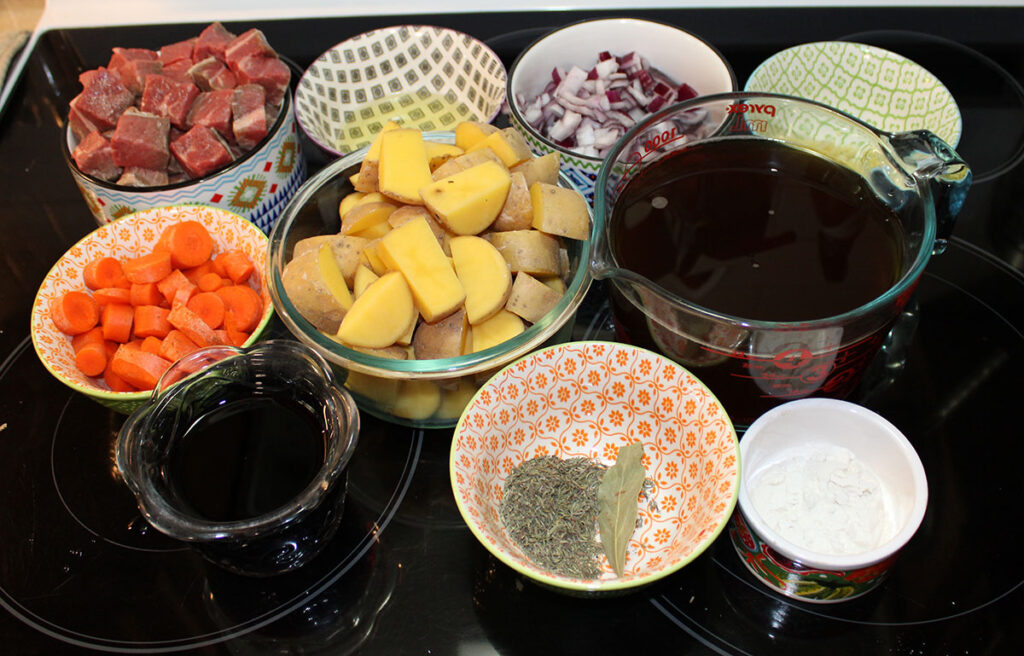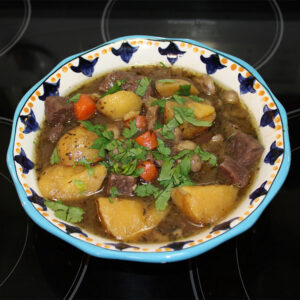Stews have always held a revered place in global cuisine, with beef stew standing out as a timeless favorite. These rich, hearty dishes, simmered slowly to draw out complex flavors, have been the epitome of comfort food across various cultures. They not only nourish the body but also evoke feelings of home, warmth, and tradition. While many nations have their unique twist on the beef stew, the essence remains the same – a reflection of the land, its climate, and its people.
Why Dublin, you ask, for a beef stew? Ireland, renowned for its verdant pastures and deep-rooted farming legacies, has been home to some of the world’s most exceptional beef. Dublin, as its vibrant capital, is a melting pot of Irish tradition, history, and culinary excellence. This city’s take on beef stew, enriched with tender Angus beef, robust root vegetables, and a broth seasoned with age-old herbs, is not merely a meal. It’s an odyssey—a gastronomic voyage that meanders through Dublin’s storied lanes, each morsel resounding with the city’s rich heritage.
Table of contents
The Culinary Heritage of Beef Stew
From the aromatic kitchens of ancient civilizations to the bustling eateries of our modern cities, the allure of a simmering pot of beef stew has remained timeless. This dish has emerged as a symbol of warmth, hospitality, and the art of slow cooking. As with any age-old culinary favorite, beef stew’s beauty lies in its adaptability, effortlessly molding itself to the tastes and traditions of regions worldwide. Through the ebbs and flows of history, beef stew has become a canvas upon which cultures painted their distinct culinary brushstrokes, celebrating the best of local ingredients and flavors.
Origins and Variations Across Cultures
The birth of beef stew can be traced back to ancient times when our ancestors discovered the transformative power of cooking meat slowly over a low flame. As cultures evolved and trade routes expanded, so did the recipe for beef stew, as it absorbed flavors, techniques, and ingredients from every corner of the world.
In France, the famed “Boeuf Bourguignon” stands out, where beef is slow-cooked in red wine, herbs, and a bouquet of vegetables. Meanwhile, in Hungary, one encounters the spicy “Goulash,” a beef stew rich with paprika and onions. The African continent offers its version with the “Potjiekos” from South Africa, where beef combines with a plethora of vegetables, slow-cooked in a cast-iron pot. Asia, with its vast culinary repertoire, gifts us with dishes like the Filipino “Caldereta” or the Japanese “Nikujaga,” both highlighting the versatility of beef stew in reflecting local palates.
Dublin’s Unique Take on the Stew
When we journey to the heart of Ireland, we’re met with Dublin’s unique rendition of this beloved dish. The city, with its cold winds and rainy days, finds solace in a pot of simmering beef stew. Dubliners have, over centuries, perfected the art of combining the richness of Angus beef with the earthiness of root vegetables. But what truly sets Dublin’s stew apart is the broth—a sublime blend of local ale or stout with traditional herbs, mirroring the city’s love for its home-brewed drinks.
Dublin’s beef stew is more than just a dish; it’s a narrative of its pastoral heritage, a tale of its lively pubs, and a testament to its enduring spirit. Each serving offers a taste of Dublin’s history, a spoonful of its culture, and a generous helping of its love for heartwarming food. Whether served in a historic pub overlooking the River Liffey or in a modern bistro in the heart of the city, Dublin’s beef stew remains an embodiment of Ireland’s rich culinary legacy.
The Alluring Charm of Dublin
Dublin, the capital of Ireland, stands as a testament to the perfect blend of the old and the new. With its cobbled streets echoing tales of ancient lore and modern high-rises narrating stories of progress, this city captures the heart of every visitor. The River Liffey, splitting the city in two, has witnessed the ebb and flow of time, as Dublin evolved from a Viking settlement to the bustling metropolis it is today. As you delve into the essence of this vibrant city, you’ll discover a rich tapestry woven with history, culture, and an undying spirit of celebration.





A Quick Peek into Dublin’s Rich History
Founded by the Vikings in the 9th century, Dublin quickly rose to prominence as a vital center for trade, arts, and politics. The medieval castles dotting the landscape whisper tales of yore, of battles fought and of poets who sang praises of this Emerald Isle. Dublin, over the centuries, played host to a myriad of events, from the Norman invasions to its struggles and eventual triumph in achieving independence. It’s not just a city of stories, but a living museum. Every brick, every alley has a story to tell, from the rebellious shouts of 1916 to the literary genius of writers like James Joyce and W.B. Yeats who once roamed its streets.
Tourism Hotspots: Must-visit Places
For the eager traveler, Dublin offers a smorgasbord of attractions. Begin your journey with a visit to the iconic Dublin Castle, a historic fortress that stands as a symbol of British rule in Ireland. For those with a penchant for literature, the Book of Kells and Old Library and the James Joyce Centre are a haven. Immerse yourself in the city’s rich musical traditions with a night out in Temple Bar, where traditional Irish tunes harmonize perfectly with modern rhythms.
Of course, no trip to Dublin would be complete without a tour of the Guinness Storehouse. Here, you’ll discover the secrets behind Ireland’s most famous export and might even learn how to pour the perfect pint. End your day with a stroll along the Ha’penny Bridge, taking in the mesmerizing views of the city by night.
Accommodations: From Luxury to Cozy Stays
Dublin, catering to a global audience of tourists, boasts accommodations for every preference and pocket. For those seeking opulence, hotels like The Shelbourne or The Merrion offer a luxurious stay with a touch of Irish charm. Boutique hotels, such as The Dean or The Marker, provide a contemporary twist to the Dublin experience.
However, if you’re seeking an authentic Dublin stay, consider the city’s vast array of cozy bed and breakfasts. Nestled in the heart of residential areas, these accommodations provide a unique opportunity to live like a local. Whether you’re sipping on a cup of tea in a Victorian townhouse or waking up to the aroma of freshly baked Irish soda bread in a countryside cottage, Dublin ensures every traveler finds their home away from home.
Savoring Dublin’s Cuisine
Dublin, often celebrated for its rich history and vibrant arts scene, is equally renowned for its gastronomic delights. The city’s culinary landscape has evolved over the centuries, imbibing influences from various cultures, yet retaining its distinct Irish essence. Dublin’s cuisine, much like its people, is hearty, genuine, and deeply rooted in tradition. While the world might associate Ireland predominantly with stews and beers, Dublin’s palate offers so much more, promising an enchanting culinary journey to those willing to venture.
Popular Irish Dishes: More than just Stews and Beers
The Irish culinary repertoire extends far beyond the famed beef stew or the iconic pint of Guinness. Begin your gastronomic journey with the traditional Irish breakfast – a hearty meal of bacon, sausages, black and white pudding, fried eggs, and a tomato, often complemented with a slice of soda bread. For those with a preference for seafood, Dublin Bay prawns or fresh oysters from the West are a must-try.
Lunch could be a delightful affair with Boxty, a traditional Irish potato pancake, or a serving of Coddle, a Dublin specialty made with sausages and rashers. And for those with a sweet tooth, the Irish apple cake or the Barmbrack, a kind of fruitcake, promises to be a delightful treat.
– Featured Restaraunt –
Old Mill Restaurant
14, Temple Bar, Dublin 2, D02 V970, Ireland
Telephone: +353 1 671 9266

Nestled in the heart of Dublin’s cultural quarter, Temple Bar specializes in traditional Irish dishes such as Irish Stew, Famous Wicklow Lamb Shank, Dublin Coddle, Cottage Pie, and Slow Cooked Beef and Guinness Stew. In addition to these classic offerings, a variety of Tender Juicy Steaks, Seafood, and Vegetarian options are also on the menu.
The Irish Love for Hearty Stews
Stews have been the cornerstone of Irish cuisine, especially during the cold, windswept winters. They offer warmth, comfort, and a sense of home. The Irish stew, traditionally made with mutton, potatoes, carrots, and onions, is a testament to the simplicity and richness of Irish cooking. Over time, variations of the stew emerged, with beef becoming a popular choice. The slow-cooked goodness, combined with fresh local produce, results in a dish that’s both flavorful and nourishing. In Dublin, stews are not just a dish; they’re a celebration of the city’s culture, history, and the indomitable Irish spirit. Whether served in a high-end restaurant or a quaint local pub, a bowl of stew is Dublin’s warm embrace to its visitors.
Step-by-Step: Crafting the Dublin-Style Beef Stew
One of the timeless joys of cooking is the journey of transforming simple ingredients into a dish that warms the soul. And when it comes to a Dublin-style beef stew, the magic lies in the marriage of traditional flavors with the chef’s unique touch. Like a symphony, every element, from the equipment to the ingredients and the cooking process, plays a crucial role in creating the final masterpiece. So, whether you’re an experienced cook or someone venturing into the world of Irish cuisine for the first time, this step-by-step guide promises to be your trusted companion in crafting the perfect Dublin-style beef stew.

Equipment Needed
- Large pot or Dutch oven
- Wooden Spoon
- Sharp Knife
- Cutting Board
- Measuring spoons and cups
Ingredients Needed
- 2 lbs Angus beef chuck roast cut into 2-inch cubes
- 3 tbsp olive oil
- 1 large onion diced
- 3 cloves garlic minced
- 4 large carrots peeled and cut into 1-inch pieces
- 4 large potatoes peeled and diced
- 4 cups beef broth
- 1 cup red wine or more broth if preferred
- 1 bay leaf
- 2 tsp dried thyme
- Salt and freshly ground black pepper to taste
- 2 tbsp all-purpose flour for thickening
- 2 tbsp water for thickening
- Fresh parsley chopped (for garnish)
Cooking Process: From Prep to Simmer
Time needed: 2 hours and 15 minutes
Cooking Directions for Dublin-Style Beef Stew with Carrots and Potatoes
- Heat the Oil
In a large pot or Dutch oven, heat the olive oil over medium-high heat.
- Season the Beef
Season the beef cubes with salt and pepper. Add them to the pot and brown on all sides. Remove and set aside.
- Sauté the Onions
Add the onions to the pot and sauté until translucent. Add the garlic and sauté for another minute.
- Deglaze the Pan
Pour in the red wine, scraping the bottom of the pot to deglaze and lift any browned bits.
- Return the Beef
Return the beef to the pot. Add carrots, potatoes, beef broth, bay leaf, and thyme.
- Bring to a Boil
Bring the mixture to a boil, then reduce the heat to low and simmer for 1.5 hours, or until the beef is tender.
- Make the Slurry
In a small bowl, mix the flour and water to create a slurry. Stir this into the stew to thicken it. Let simmer for an additional 15 minutes.
- Adjust the Seasonings
Adjust seasonings, garnish with fresh parsley, and serve hot.
If you liked this dish please Rate This Recipe and leave a comment.
Beef Stew with Carrots and Potatoes
Please Rate this Recipe
Equipment
- Sharp Knife
- Measuring spoons and cups
Ingredients
- 3 tbsp olive oil
- 2 lbs Angus beef chuck roast cut into 2-inch cubes
- salt and freshly ground black pepper to taste
- 1 large red onion diced
- 3 cloves garlic minced
- 1 cup red wine or more broth if preferred
- 4 large carrots peeled and cut into 1-inch pieces
- 12 small yukon gold potatoes peeled and diced
- 4 cups beef broth
- 1 bay leaf
- 2 tsp dried thyme
- 2 tbsp all-purpose flour for thickening
- 2 tbsp water for thickening
- fresh parsley chopped (for garnish)
Instructions
- In a large pot or Dutch oven, heat the 3 tbsp olive oil over medium-high heat.
- Season the 2 lbs Angus beef chuck roast cubes with salt and freshly ground black pepper. Add them to the pot and brown on all sides. Remove and set aside.
- Add the 1 large red onion to the pot and sauté until translucent. Add the 3 cloves garlic and sauté for another minute.
- Pour in the 1 cup red wine, scraping the bottom of the pot to deglaze and lift any browned bits.
- Return the beef to the pot. Add 4 large carrots, 12 small yukon gold potatoes, 4 cups beef broth, 1 bay leaf, and thyme2 tsp dried thyme.
- Bring the mixture to a boil, then reduce the heat to low and simmer for 1.5 hours, or until the beef is tender.
- In a small bowl, mix the flour2 tbsp all-purpose flour and 2 tbsp water to create a slurry. Stir this into the stew to thicken it. Let simmer for an additional 15 minutes.
- Adjust seasonings, garnish with fresh parsley, and serve hot.
Nutrition
Complementary Dishes
As delicious and hearty as the Dublin-style beef stew is, pairing it with complementary dishes and drinks can elevate the entire dining experience. Just like a beautifully set stage enhances a performance, the right accompaniments highlight the stew’s flavors and add layers to the meal. The beauty of this iconic Irish dish is its versatility. Whether you’re looking for a rustic, homey meal or a sophisticated dinner, with the right pairings, your Dublin-style beef stew can shine in any setting.
What Pairs Well with Your Beef Stew?
Dublin-style beef stew, with its rich flavors, pairs wonderfully with side dishes that can absorb its juices and enhance its taste. A crusty Irish soda bread, slightly warm from the oven, is perfect for mopping up the stew’s flavorful broth. For a lighter touch, consider a fresh green salad with a tangy vinaigrette dressing. This offers a refreshing counterpoint to the stew’s richness. If you’re in the mood for something more substantial, a side of colcannon—creamy mashed potatoes with sautéed kale or cabbage—serves as an ideal companion, staying true to the Irish theme.
Drinks to Enhance Your Dublin-Style Dinner
When thinking of drinks to accompany your beef stew, it’s essential to consider beverages that can hold their own against the stew’s robust flavors. A pint of Irish stout, like a Guinness, mirrors the deep, malty notes used in the stew, creating a harmonious blend of flavors. For wine lovers, a glass of full-bodied red wine, such as a Cabernet Sauvignon or a Malbec, complements the beef’s richness. If you’re looking for non-alcoholic options, consider a sparkling apple cider or a tangy blackcurrant cordial. Both choices offer a sweet-tart note, cutting through the stew’s richness and refreshing the palate.
Storing and Reheating Tips
Ah, the joy of savoring a well-made Dublin-style beef stew doesn’t just end with the initial feast. The magic often lies in the subsequent servings, where the flavors have melded and matured, making the leftovers a treat unto themselves. However, the key to relishing this dish a second or third time is in proper storage and reheating. Much like preserving memories from a trip to Dublin, storing and reheating your beef stew correctly ensures you can revisit its deliciousness time and again without losing its essence.
Making the Most of Leftovers
Leftover stew is almost a tradition. Over time, the ingredients continue to marinate, intensifying the flavors. But to make the most of this, you need to store it correctly. Once cooled to room temperature, transfer the stew to airtight containers, leaving about an inch of space at the top to allow for expansion. If you’re planning to savor it within the next 3-4 days, the refrigerator will suffice. For longer storage, consider freezing the stew in portioned containers. This way, you can thaw and reheat only what you intend to consume, keeping the rest preserved for future meals.
Ensuring Flavor Retention
Reheating is an art. Do it wrong, and you risk losing the dish’s complexity and depth. When you’re ready to enjoy your stew again, if it’s frozen, allow it to thaw in the refrigerator overnight. For reheating, use a pot on the stove over low to medium heat, stirring occasionally. The slow heating process helps in retaining the stew’s flavors. If you find the stew has thickened too much during storage, add a splash of broth or water to reach the desired consistency. Microwaving is an option, but using the stove ensures even heating and flavor retention. Before serving, do a quick taste test. Sometimes, the flavors may need a slight adjustment, like a pinch of salt or a dash of pepper, to bring the dish back to its initial splendor.
A Flavorful Farewell: Wrapping Up Our Dublin-Style Journey
As we reach the end of this gastronomic exploration, it’s a moment of reflection, a pause to savor the journey we’ve undertaken. From the bustling streets of Dublin to the comfort of our own kitchens, the Dublin-style beef stew has offered us a unique culinary experience, bridging the gap between a historic city’s charm and our quest for heartwarming, flavorful dishes. This isn’t just a recipe; it’s a narrative of tradition, culture, and the universal love for good food.
Reflecting on the Culinary Journey
Every bite of the Dublin-style beef stew is a testament to the rich tapestry of Irish culinary traditions. The hearty blend of beef, carrots, and potatoes, simmered to perfection, is more than just a dish. It embodies the spirit of Dublin, a city steeped in history and culture. Making this stew isn’t just about feeding our bodies; it’s about nourishing our souls, connecting with a legacy, and creating memories that will linger long after the last bite is savored.
Inviting Readers to Share Their Experiences
And now, dear readers, it’s your turn to take center stage. Whether you’ve followed this recipe to the letter or added your own twists, we’d love to hear about your experiences. Did the stew transport you to the cobbled streets of Dublin? Or perhaps it evoked a cherished memory? Every culinary endeavor is a story waiting to be told, and we invite you to share yours. Comment below, connect with us on our social channels, or drop us an email. In the end, food is a universal language, and your tales add richness to this ever-evolving conversation.
Photo Credits:
- By Taste The World Cookbook – Copyright 2023 All rights reserved.
- By Old Mill Restaurant
- By Giuseppe Milo – Imported from 500px (archived version) by the Archive Team. (detail page), CC BY 3.0, https://commons.wikimedia.org/w/index.php?curid=107083068
- By J.-H. Janßen – Own work, CC BY-SA 3.0, https://commons.wikimedia.org/w/index.php?curid=22097879
- By Charles Nadeau from San Mateo, CA – O’Connell Bridge, CC BY 2.0, https://commons.wikimedia.org/w/index.php?curid=71668429
- By Donaldytong – Own work, CC BY-SA 3.0, https://commons.wikimedia.org/w/index.php?curid=7196082
- By William Murphy – https://www.flickr.com/photos/infomatique/48958679793, CC BY-SA 2.0, https://commons.wikimedia.org/w/index.php?curid=120305259

